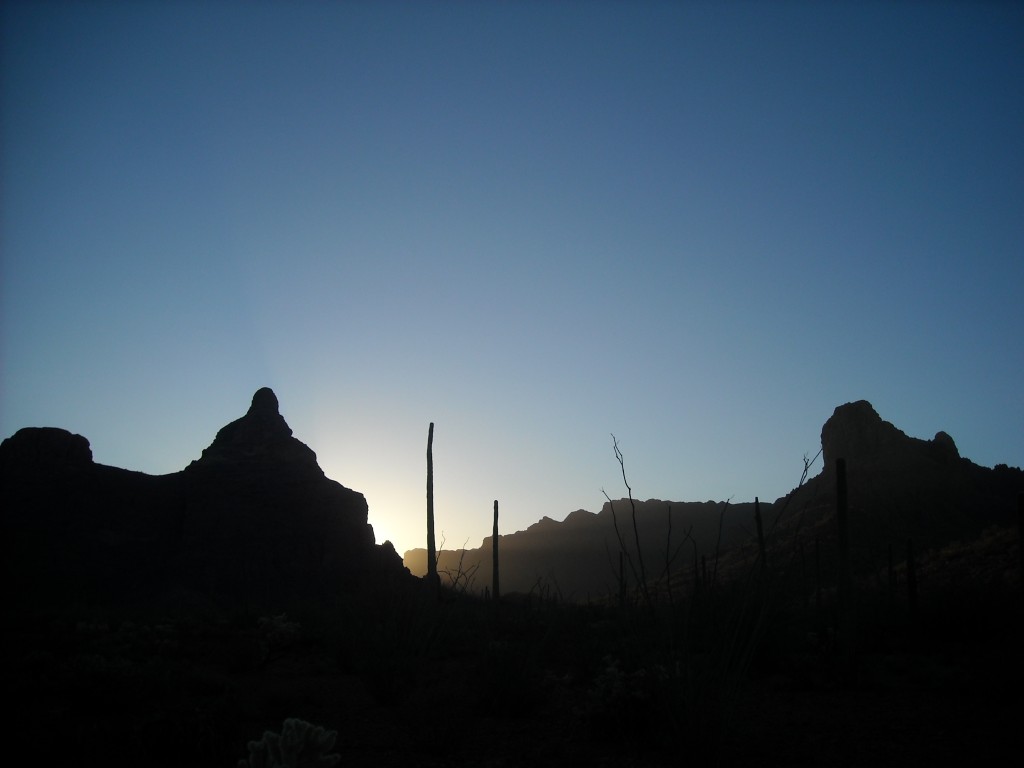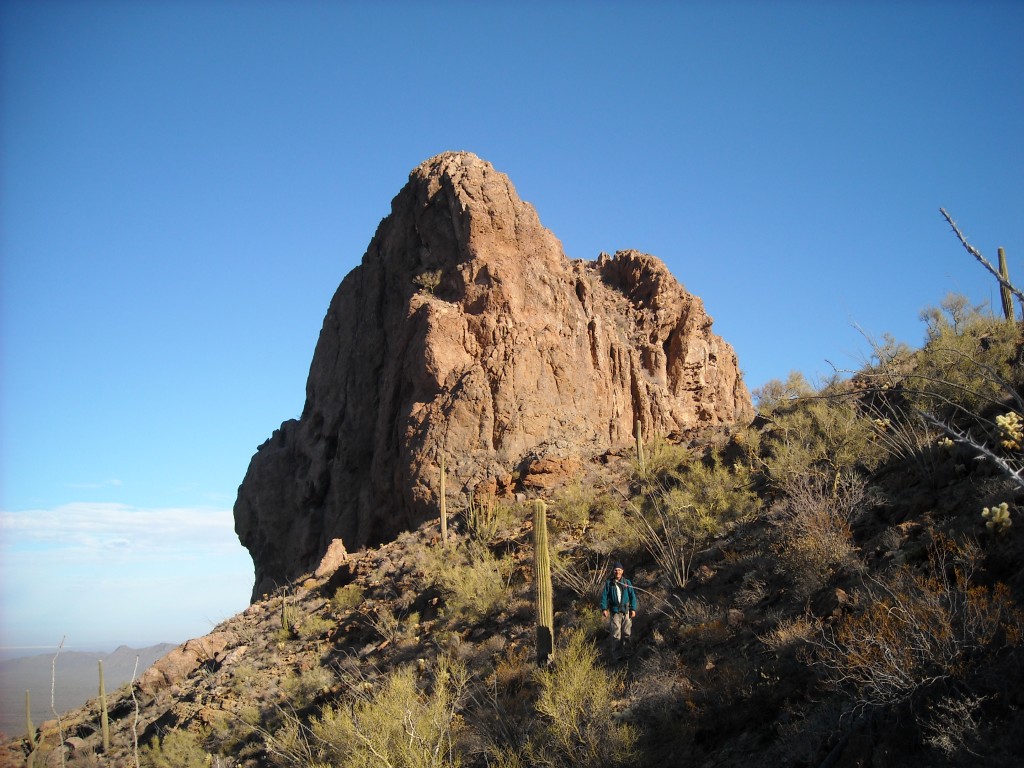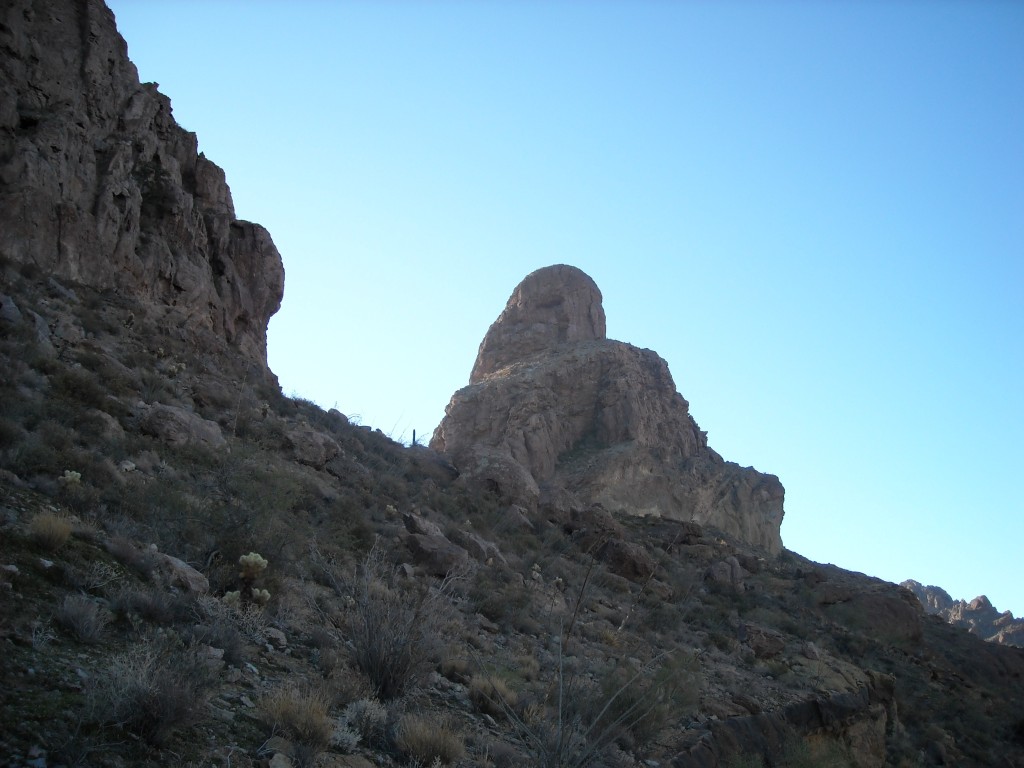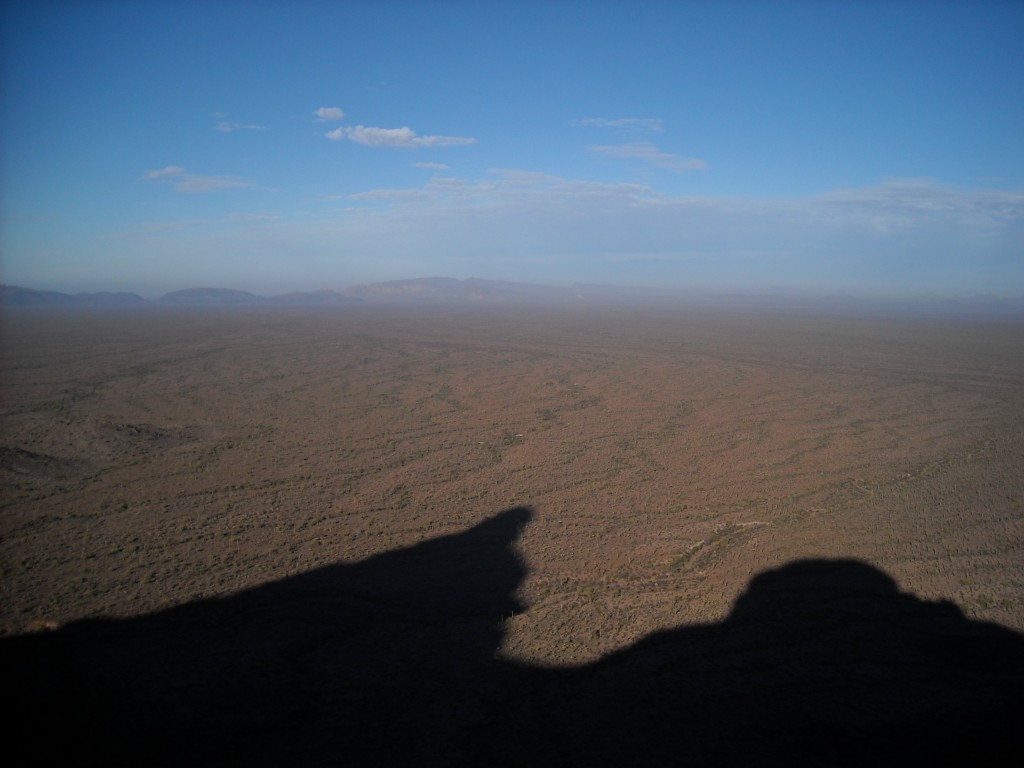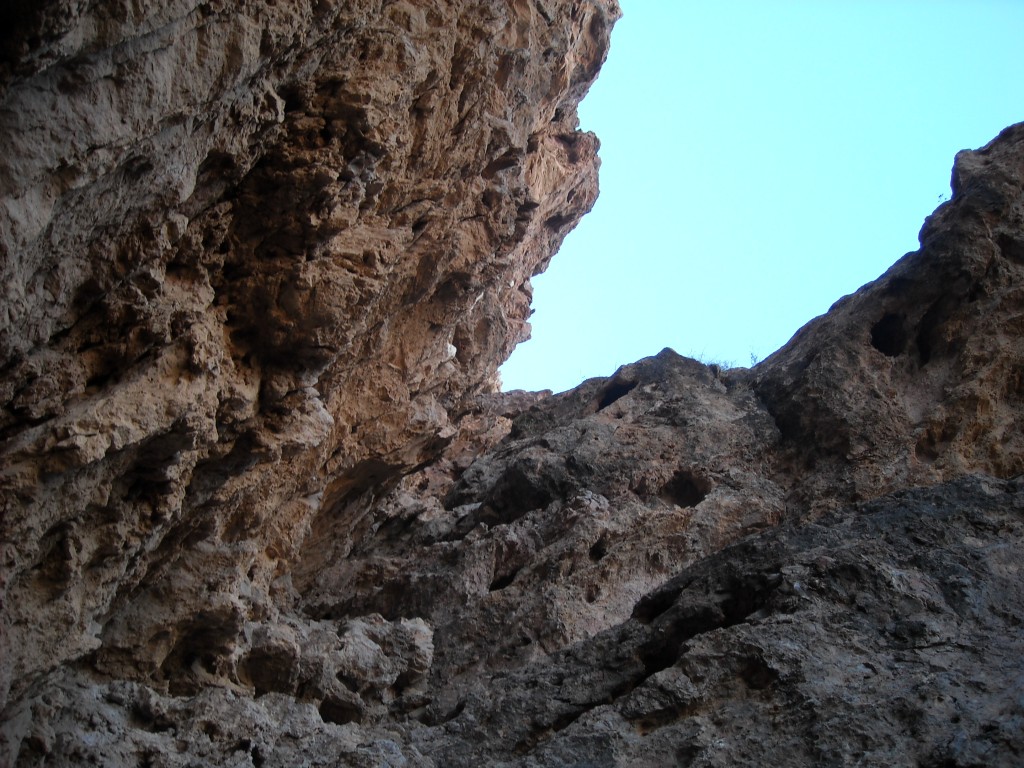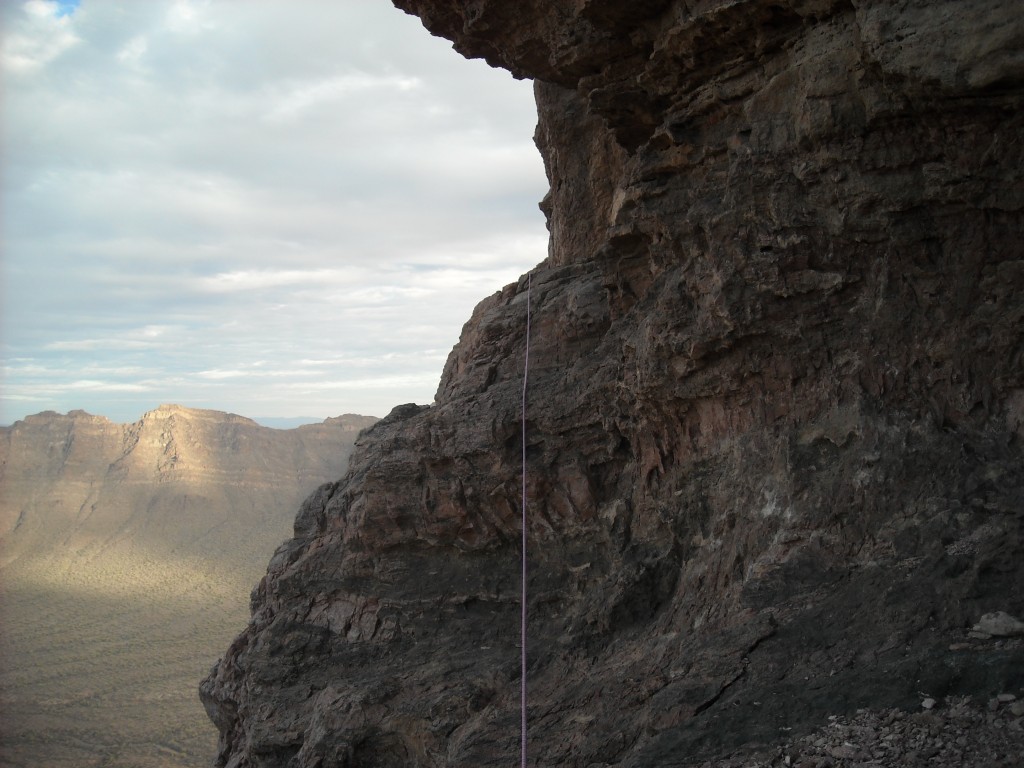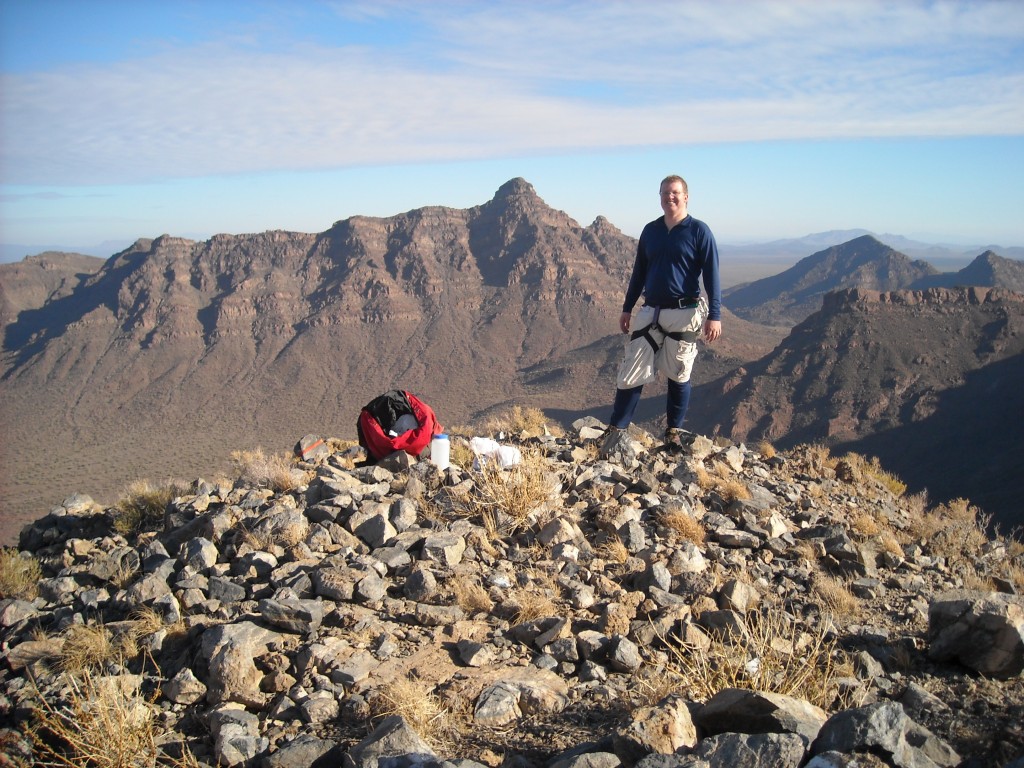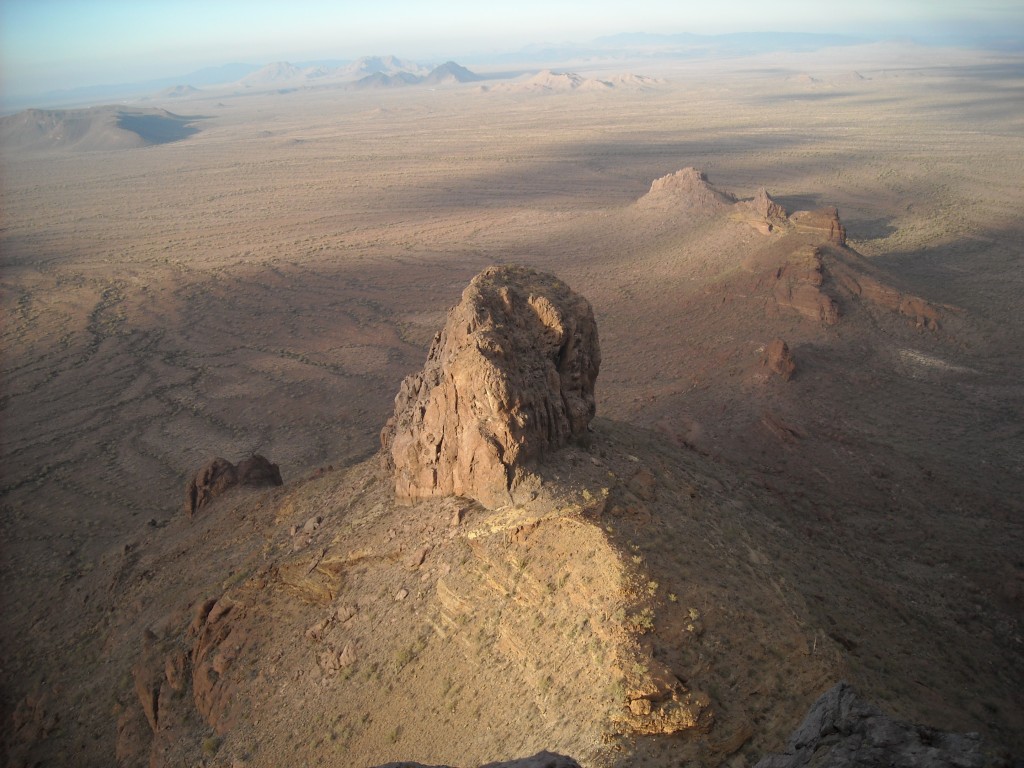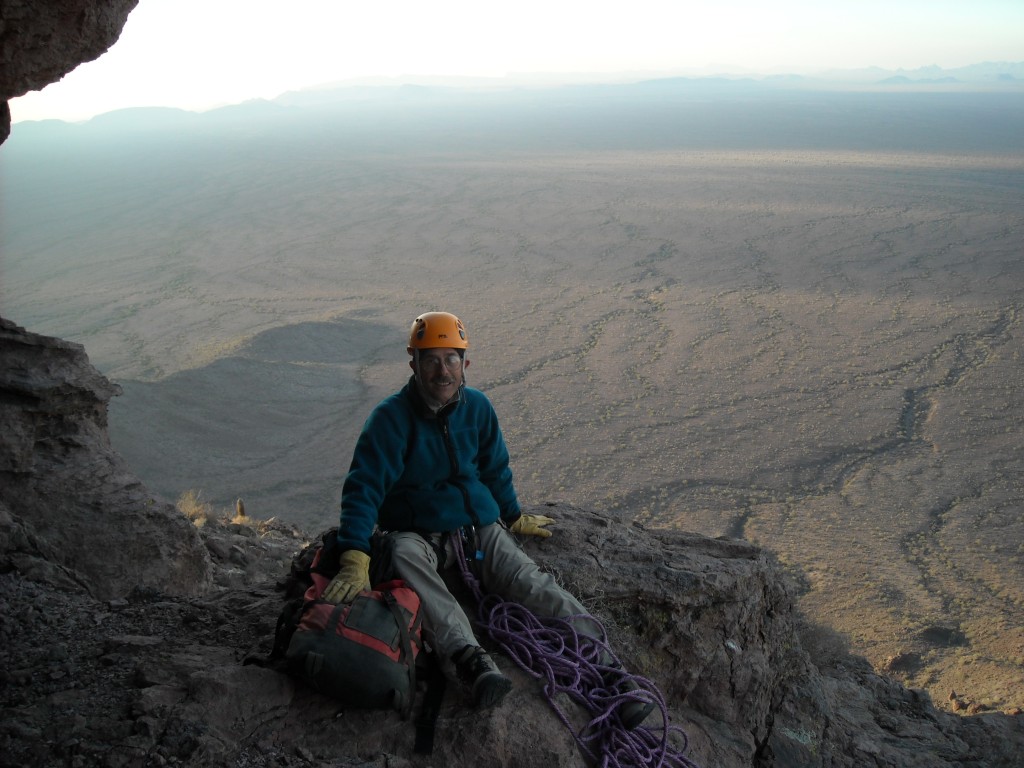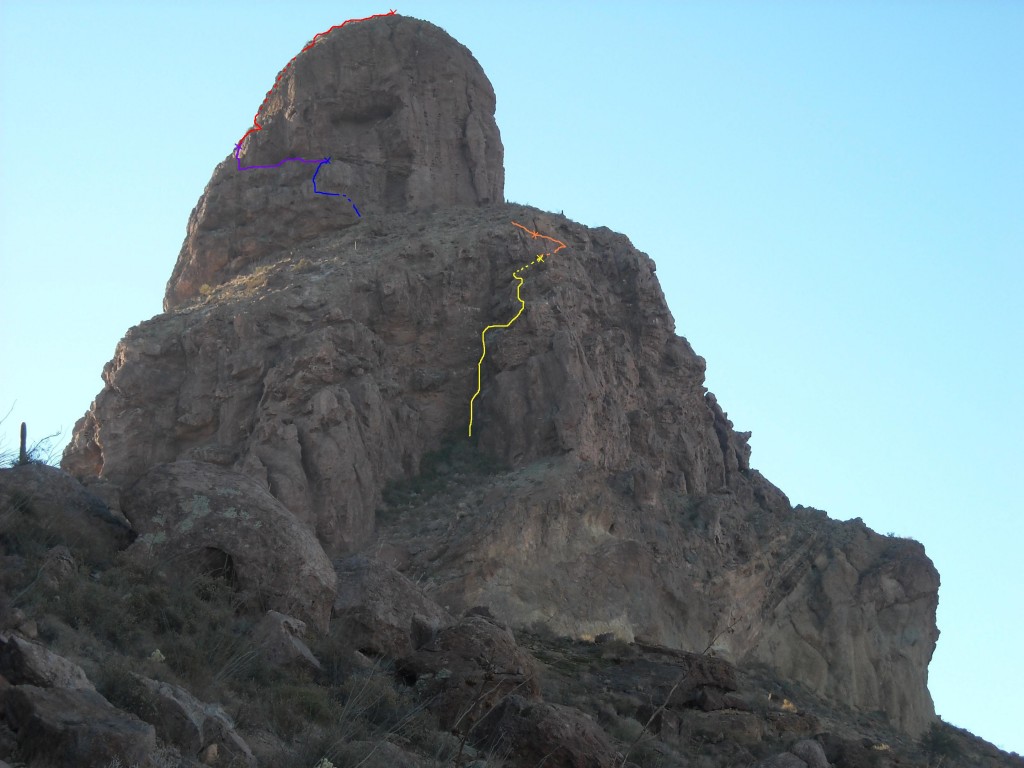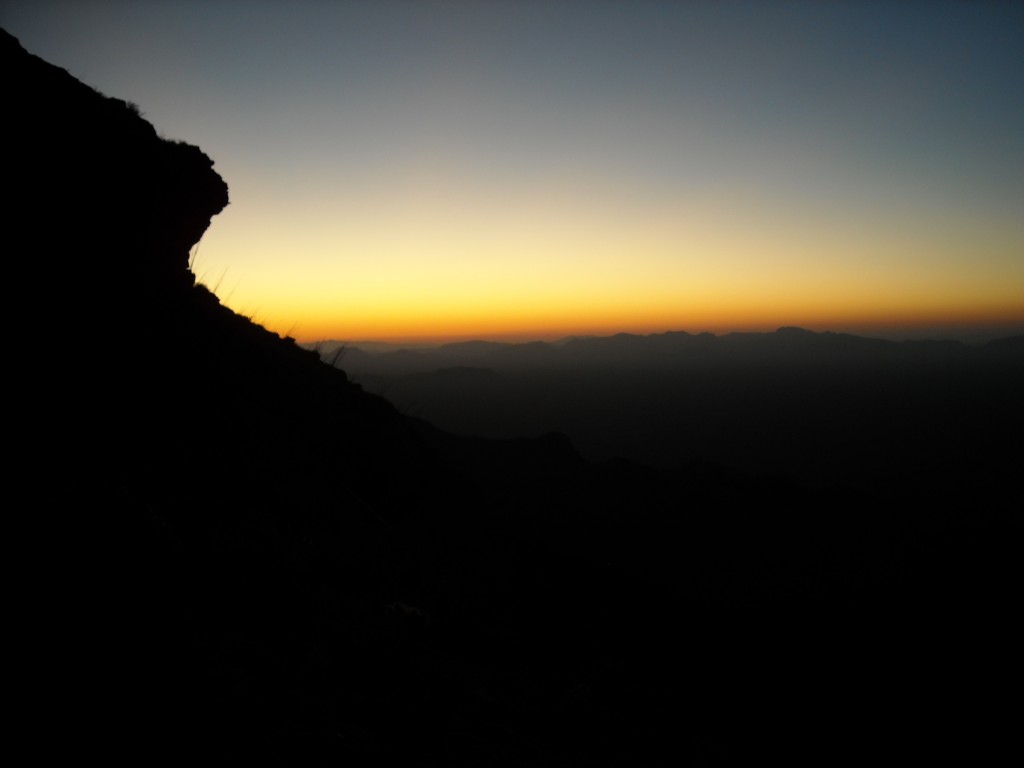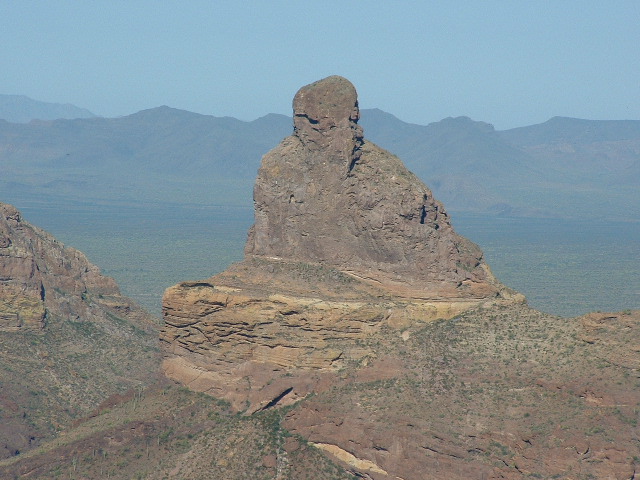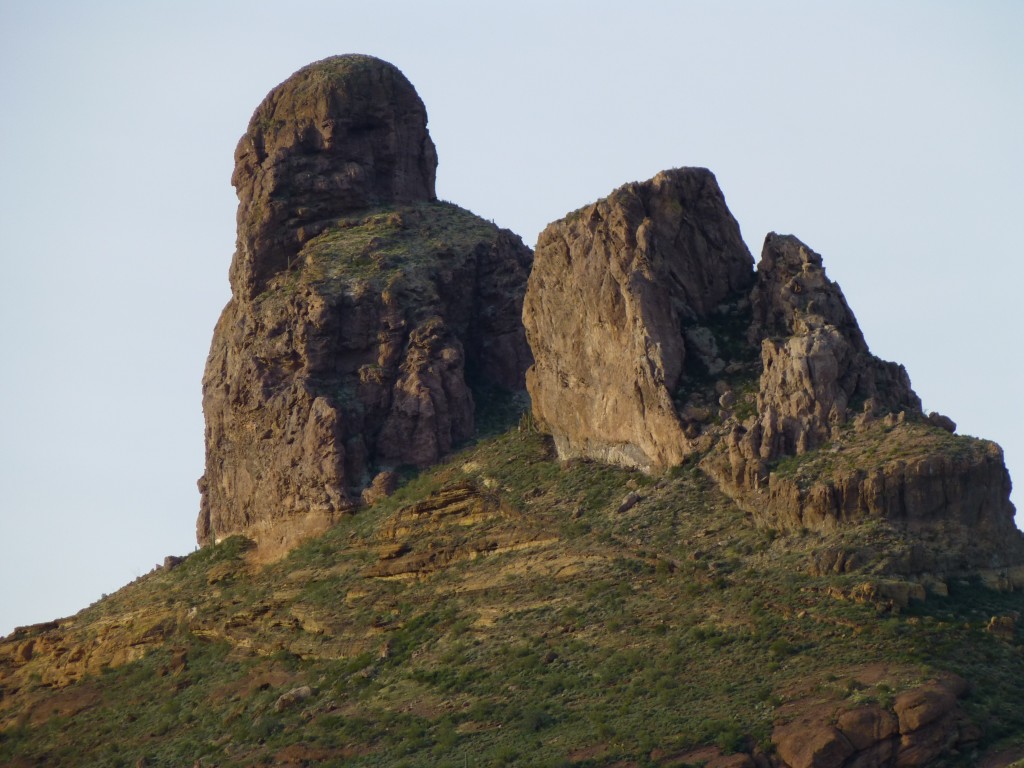It’s hard to miss this peak – from much of the area around Ajo, Arizona, it stands like a stone sentinel, guarding the northwest corner of the Ajo Range. It’s a fearsome-looking tower with a lot of vertical rock. I knew little about it. The first story I’d heard of it was when an idiot climber I knew from Tucson had accidentally locked his keys in his car when he’d gone to climb it. He’d phoned his wife and asked her to bring his spare keys – a five-hour round trip from Tucson – which she did, just so he wouldn’t have to break in to his car to retrieve them. You’d think he could’ve made more of an effort to get inside the vehicle.
The next I’d heard of Montezuma’s Head was when Dave Jurasevich led a group to it. They got part-way up the thing, but had to abort the climb as they were running out of daylight. Dave returned at a later date with Andy Bates – both of them were accomplished rock climbers – and they polished it off in style. Which brings us to me. At the time, I was working on a list of 1,000-foot-prominence peaks in Pima County, and this one was on the list. I enlisted the help of Andy, who’s always willing to lend a hand to climbers in need. He agreed, but he might have regretted it later.
At 4:00 am on December 10, 2009 Andy arrived at my home in Tucson (after having driven directly down from Phoenix) and we immediately left in my old 1987 Toyota 4WD pickup. We drove in the dark all the way across the Tohono O’odham Indian Reservation to the village of Why, AZ and then south for 9.5 miles on AZ Highway 85 to a big roadside parking lot. We only needed a few minutes to get packed up and we left the truck at 6:38 am.
We walked across the flat desert at a bearing of 102 degrees. It was good going, with only a few gullies to cross through, the last one being Pitahaya Canyon. Montezuma’s Head has a northern outlier, which is about 400 feet lower than the main summit.
We climbed up through brushy terrain directly towards the northern bump, gaining about 900 vertical feet and getting above a prominent band of yellow rock.
Then, it was an easy southerly traverse over to the saddle between Montezuma’s Head and its northern outlier.
This was a good place to sort gear and get organized for the climb ahead. We also left here extra food and water. It had taken us three hours to get from the truck to the saddle, travelling about 4.5 miles and gaining about 1,300 vertical feet in the process.
The real climbing starts here. From the saddle, there is about 600 vertical feet of climbing to the 3,634′ summit. The first part is straightforward. We climbed up the rocky divide for a bit, then used some ledges and slabs to get through a section of Class 2-3, then walked up an inclined but non-technical section of open ground, arriving at the base of the climb proper. This leaves about 350 vertical feet to the summit.
Pitch #1: The start of this pitch is a dark, cheerless place. Imagine a gully about 20 feet wide and about 20 feet deep – then stand it on end at an angle of 80 degrees, on the NNW side of the summit. The sun never shines into the depths of this gully due to its location – it was something straight out of the depths of Mordor. It was 10:50 AM and chilly. Andy put on his rock shoes. We roped up. Andy led, of course, and I belayed him from a standing position. It wouldn’t have paid for me to have been tied in to anything, as I had to be able to move around to dodge the rain of loose rock that Andy dislodged as he climbed (there was no help for this, as the rock was very rotten and crumbly in places). The first few feet of this pitch were up steep but fairly good rock, Class 4, up to an old pin with a hanger, at maybe 12′ off the ground. At about 20′ above me, Andy had to wiggle into a nasty chute in the deepest part of the gully. This was really tricky, very awkward and risky. The holds were poor, the rock was loose and gritty and it was hard to protect. Depending on exactly the path one chose, this would be low to mid 5th-class. This area also caused most of the rockfall. Chunks from the size of peas up to baseballs were raining down on me, and I was glad to be able to move around freely while belaying Andy.
He did a great job in this crux part of the pitch, with some nice stemming moves. 35′ up, Andy put a sling around a natural pillar of rock, our second piece of protection. At about 50′ up, he did the same with another of these pillars. He had climbed this pitch twice before, and he had been thinking a lot about this part of the climb. He hoped we could avoid a large red rock which sat directly in our path higher up. At that 50′ mark, he had reached a nice ledge, and thought he would explore a bit. He moved off to the right, out of the chute (thankfully), and disappeared from sight. After a short while, he shouted down to me that he had found a route that would go. He had travelled about 30′ over, descended a bit on to easier ground (actually he had stayed fairly level, over much tougher ground – I was the one who would descend to the easier ground) then rounded a corner, climbed up and left to a ledge (this was exposed 4th-class in spots) and reached a nice spot where he could bring me up. This variation on the first pitch made it a total length of about 125′. Also, this variation makes this pitch a bit friendlier and safer than the direct route up the gulley through the reddish rock area.
He tied in to a large boulder near the west face of the mountain. Now it was my turn. Andy took up the slack (our rope was 70 meters, or about 230 feet long). I started climbing with the pack (it contained drinks, food, extra clothes, first-aid, headlamps, etc, so Andy could lead the climb unencumbered). It was quick work up to the start of the chute, 20 feet up. By far the hardest part of this pitch was, for me, wiggling up into the chute. It was hard work, and I was impressed how easy Andy had made it look. For me, it wasn’t easy at all. I finally got up into this chute, then my pack jammed against a sharp bit of rock above me. There wasn’t much room to manoeuver, and it would have gone better if, in the midst of my wiggling I hadn’t got a small cramp in my right calf. I panicked for a moment, because I knew if the cramp turned into a full-fledged world-class cramp like I sometimes get, the climb would be over for me. I don’t know how, but I got loose and climbed farther up, and the cramp passed. I got up to the ledge, rested a bit, then moved out to the right. I took an easier, descending path than Andy had done, then followed his route up to where he belayed me. It took us 1 hour 25 minutes to complete the first pitch. There is a LOT of exposure on the west face shortly after leaving the chute.
Pitch #2: We simply left the sling (at least a 15′ sling is needed here) around Andy’s boulder from which he had belayed me. This is a nice big flattish spot on which you can move around easily, avoiding the west face about ten feet away. We tied in and away went Andy. He stepped up on to a ledge about 15′ away from where I was sitting, then moved up on to and around a rock fin (mid 5th) and up on to a ledge. He walked south about 20′ on easy ground, then scrambled up easy Class 2 about 10′ to a small boulder, around which he put a sling to belay me. Once on belay, I moved up fairly quickly. The reason it didn’t take long is because I refused to look down at the huge exposure below the rock fin, and I just got it over with as soon as possible. The second pitch only took us a total of 25 minutes. The spot from which I belayed Andy as he led the second pitch was the only one on the whole climb where the belayer gets a bit of sunlight.
Once we unroped after the second pitch, we walked up to the left and up an easy open slope, gaining about 30 vertical feet and covering about 200 feet total distance. This took us to the start of the third pitch. Andy said that on a previous attempt, their party spent a lot of time route-finding, to try to find the start of the third pitch. Fortunately, today he knew exactly where it was, as he and Dave Jurasevich had climbed the peak by this route eight years earlier.
Pitch #3: This was another standing belay. Andy moved up, climbing perhaps 15 vertical feet of Class 3, then moved left on to a narrow ledge with barely enough room on which to stand upright. He followed this ledge for about 15 feet horizontally, where he was able to clip a pin before moving around an awkward bulge (a lot of exposure here) and over a gap in the ledge, then up 6 feet of Class 5.5 rock to easier rock slopes, where, above this he reached a flat area with a 2-bolt anchor off to the right. From here, he brought me up. A total of 50 minutes had passed since we completed the 2nd pitch.
Pitch #4: Once again in the shade, and wearing all my layers of clothing, I sat down and belayed Andy. It was chilly, maybe 55 or 60 degrees with the wind coming and going. I had heard a lot of horror stories about this next pitch, and I was not to be disappointed. Andy started out by climbing up 5′ to the left on a shelf (very exposed), then around the corner to the right and out of sight, on to another shelf which he hollered back to me was “really nice and wide”.
Sure, I thought, we’ll see! He’s probably just saying that to make me feel better. After a short while, he reappeared ahead. He then climbed up and around a corner and was out of sight once again. It was pretty hard to hear him from there. He told me he was setting up a belay. The leader on a climb like this is always busy, with lots to do and lots of responsibility. The second on the rope, by contrast, spends a lot of time just sitting there, paying out the rope, often unable to see or hear the leader. It can be very frustrating, and that’s how I felt. I kept yelling out at Andy, asking how it was going, and he would patiently tell me that it was fine, that he was setting up a belay. Finally, he hollered out that I was on belay. I was glad to stand up and get out of the cramped position I had been in, seemingly forever. An important note about this pitch is as follows – it is mostly a horizontal traverse, and hard to protect – both leader and second need to be very careful.
I started out, passed the shelf, then around the corner. Wow, Andy wasn’t kidding, the ledge was maybe ten feet wide, with a big overhanging roof. I headed east along it, and it narrowed. Andy had clipped into a pin there, to make me feel better. I didn’t clean the route, as we were both going to need to backtrack and wanted all of the protection still in place for our return. Where the ledge narrowed, there was a corner, and then a step over a gap about a foot wide. But what a gap! The exposure was horrific – you could look down between your feet and right down the whole east face of the mountain. Just for fun, to see how steep this side of the mountain is, log on to Google Earth and go to these coordinates:
32 degrees 06′ 53.20″ North 112 degrees 42′ 21.89″ West
Once you have the summit in view, you can hold down the cursor and move it around to see a nice 3D view of the mountain. North is of course at the top.
Anyway, once across the gap, I climbed up about 8′ (4th class) around a corner, on to the east face proper. There is a bolt there. Now, I was at the base of a 10′ piece of rock, vertical, a stiff class 5.6 with small holds. I was about ready to start crying like a little girl. I got up this, to where Andy was tied in to 2 bolts, practically hanging off the side of the mountain. He had a big grin on his face, and said “Isn’t this view amazing?” All I wanted to do was get on a solid footing, so I scrambled up behind him and hung on to a bush or a rock or something – I can’t even remember! He said “That’s it, we’re done!” Then I looked up – we weren’t done!!! – the mountain towered up above us, at a 60-degree angle, in a series of ledges. I told Andy that I had no intention of just climbing up this series of ledges unroped. Although the climbing was not difficult, maybe Class 3, and there were plenty of good holds, the exposure was still unbelievable. Andy said it was no problem for him to belay me up the last part to the summit, so, both still tied to the rope, he climbed further up for quite a way until he was out of sight. I stood there on a ledge with my face close to the rock, hanging on to a bush for some psychological comfort – truth be told, I was completely unnerved at this point. After a while, I faintly heard Andy shout down that I was on belay. He took up the slack, then it only took a few minutes for him to bring me up the last hundred feet or so, and there we were, a short stroll from the summit.
We had made it – the summit of Montezuma’s Head, 3,634′. It was 3:00 PM. The summit is not flat – it is a rounded dome, but there is plenty of room to unrope and safely walk around. We found the register inside a summit cairn and signed in. The previous ascent had been done in April of that year. It looked like the mountain was only climbed every one or two years (I thought it would be more often). Andy’s entry was there, from his 2001 climb with Dave. I still felt nervous about getting all the way back down to more level ground, and I was concerned about being benighted on the mountain. Andy and I have done a bunch of rappeling in the dark, and it was not fun – I didn’t want to do more of it. The view was spectacular, and it was a perfect day, but I still wanted to start down. I think Andy wanted to stay on top a while longer, but he could see I was nervous and he kindly agreed to start back down.
We tied in, and at 3:30 I walked down the ledges to the bottom of our “fifth pitch” to the 2-bolt anchor. I clipped in and waited for Andy as he walked down to me, unroped – I wish I had his level of comfort in exposed places like that. At 3:50 PM, we were both at the top of the 4th pitch. We set up the belay and I started down and soon arrived at the next belay station. We were both there by 4:45 PM. I felt better already with that 4th pitch behind us.
We rappeled to the west straight down the 3rd pitch, about 70′, bypassing all of the climbing route, through a nice overhang. Rappelling down the second pitch was also the work of a few minutes, with the breathtaking sheer drop of the west face below our feet. We arrived at the top of the first pitch at 5:00 PM. Since all of our belay anchors were still in place, setting up each rappel was very quick. It is strongly recommended to use a 70-meter rope to rappel the first pitch. You might be able to do it with a 60-meter rope, but it would be too close for comfort. If you needed it, there is a 2-bolt rappel station on a medium-sized ledge about 25′ above the start of the first pitch. Rapping this pitch avoids the nasty chute, and there is a big overhang as well. We were both on terra firma at the base of the first pitch by 5:25 PM. We quickly gathered up gear, Andy put on his hiking boots and we hurried down to the saddle. We did a final sorting of all the gear while the sun set below the horizon, then away we went. We hadn’t gone very far before it was totally dark. Here’s a view looking back up at the peak, taken early in the day. The pitches are shown. Pitch #1 is yellow; #2 is orange; #3 is blue; #4 is purple; #5 is red.
And here’s a view of the last light, after the sun had already set.
I had just bought a new headlamp, which had a useable range of over 100 meters, so with it, we negotiated our way down through the brush and small cliffs below the yellow band. It would have been tough doing this with no light, as there was no moon and the night was inky black. Andy’s headlamp died as we worked our way below the yellow band. Once down on to the flat desert, Andy gave us a bearing with his GPS and we just kept walking. The hours passed, and we arrived back at the truck at 8:48 PM. The climb had lived up to its reputation. It was cold, cramped and very scary. The exposure was breathtaking in all the right places. The climb had taken us 14 hours 10 minutes. Thanks to Andy for putting up with my whining during the climb.
Here are a couple of photos that show Montezuma’s Head from some different angles. This first one was taken from Peak 3650, two miles to the east. See the right-hand side of the pillar? Just below the distant mountain ridge in the background is a dark horizontal indentation – that’s where the fourth pitch comes towards us and ends on the vertical face.
Here’s another view, this one a telephoto shot from the desert floor to the north, fifteen hundred feet below the summit. Take a gander at the left side – that’s the east face. That fourth pitch exits on that face, 80% of the way up it.
Thanks to Andy for the use of his photos in this piece.
Oh yes, one final bit of trivia. A few months after our climb, our friend John Klein was climbing the peak with a partner. In the middle of their climb, a magnitude 7.2 earthquake hit Ensenada in Baja California. He said they strongly felt it up on the peak. Man, that’d scare the bejeezus out of me if I were up there at that moment.
Please visit our Facebook page at: https://www.facebook.com/pages/Desert-Mountaineer/192730747542690

